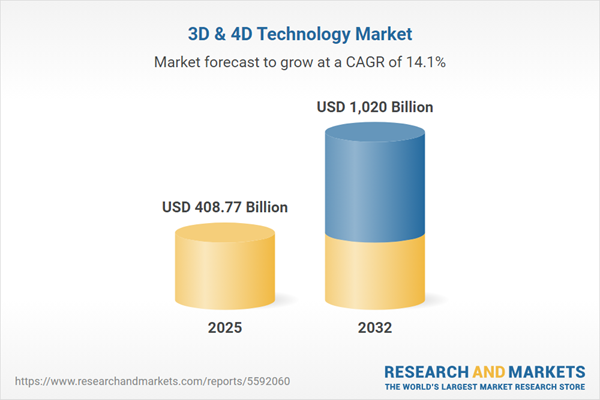Speak directly to the analyst to clarify any post sales queries you may have.
The 3D & 4D Technology Market is undergoing significant transformation, offering decision-makers in manufacturing, healthcare, and engineering vital pathways to innovate, streamline workflows, and enable adaptive product solutions.
Market Snapshot: 3D & 4D Technology Market Growth Overview
In 2024, the 3D & 4D technology market was valued at USD 357.72 billion and is forecasted to reach USD 408.77 billion in 2025. The sector is projected to sustain a compound annual growth rate of 14.10%, reaching USD 1.02 trillion by 2032. Demand for advanced additive manufacturing is expanding, driven by developments in three-dimensional fabrication and adaptive four-dimensional printing, as organizations from aerospace to healthcare increasingly integrate these solutions into operations.
Scope & Segmentation
This report provides a comprehensive breakdown of the 3D & 4D technology landscape, examining crucial adoption factors, technical pathways, and competitive positioning:
- Technology Types:
- 3D printing includes directed energy deposition, material extrusion, material jetting, powder bed fusion, and vat photopolymerization.
- 4D printing encompasses hydrogels and shape memory polymers.
- Material Types:
- Ceramics (alumina, silica)
- Composites (carbon fiber reinforced polymer, glass fiber reinforced polymer)
- Metals (aluminum, stainless steel, titanium)
- Plastics (ABS, nylon, PLA)
- End Use Industries:
- Aerospace, automotive, consumer goods, education, electronics, healthcare (including bioprinting, medical devices, prosthetics)
- Processes:
- Directed energy deposition (laser metal deposition)
- Material extrusion (FDM)
- Material jetting (PolyJet)
- Powder bed fusion (SLM, SLS)
- Vat photopolymerization (DLP, SLA)
- Applications:
- Production (low volume, mass customization)
- Prototyping (functional, proof of concept)
- Research and development (material, process development)
- Tooling (jigs, fixtures, molds)
- Geographic Coverage:
- Americas (North America, Latin America)
- Europe, Middle East & Africa (Europe, Middle East, Africa)
- Asia-Pacific (including key economies across regions)
- Company Analysis:
- Focus on leading players such as Stratasys Ltd., 3D Systems, HP Inc., EOS GmbH, and several others influencing technology adoption and innovation.
Key Takeaways: Strategic Market Drivers & Competitive Insights
- Integration of 3D and 4D printing is redefining design, prototyping, and production processes, enabling intricate geometries and adaptive behaviors within products.
- Distributed additive manufacturing networks are facilitating local production, reducing lead times, and limiting logistical vulnerabilities in highly regulated sectors.
- Material and process advancements in polymers, metals, ceramics, and composites support a growing scope of end-use applications, from mission-critical aerospace components to custom healthcare devices.
- Collaboration among equipment manufacturers, material suppliers, software developers, and end users is accelerating innovation cycles and supporting the expansion of qualified materials and production capabilities.
- Open data standards and increased interoperability are enabling seamless integration across OEMs, service bureaus, and supply chain partners.
- Regional initiatives in Asia-Pacific, Europe, and the Americas are shaping technology qualification, regulatory alignment, and supply chain resilience, underscoring the role of localized policy and investment strategies.
Tariff Impact: U.S. Policy and Market Dynamics
Recent U.S. tariffs on select additive manufacturing equipment and materials have driven organizations to reconsider procurement strategies, prompting a shift toward near-shore suppliers and increased emphasis on domestic material development. This localized focus is reinforcing intellectual property development and manufacturing resilience, while reshaping vendor relationships and cost management strategies.
Methodology & Data Sources
The research methodology combines systematic literature reviews, primary expert interviews, and proprietary quantitative data collection. Insights are validated through cross-referencing of market intelligence, company disclosures, and segment-specific data, ensuring a robust and up-to-date analysis for senior business leaders.
Why This Report Matters
- Enables executives to anticipate and respond to sectoral and regulatory shifts impacting additive manufacturing strategies.
- Provides actionable segmentation analysis to inform resource allocation, supply chain planning, and market entry initiatives.
- Delivers competitive intelligence to guide partnership decisions and innovation priorities in a rapidly evolving market.
Conclusion
The 3D & 4D technology market is evolving rapidly, characterized by maturing digital workflows, material breakthroughs, and collaborative innovation. Senior leaders equipped with comprehensive insights can drive future-ready strategies, maximize value, and foster sustainable growth in additive manufacturing.
Additional Product Information:
- Purchase of this report includes 1 year online access with quarterly updates.
- This report can be updated on request. Please contact our Customer Experience team using the Ask a Question widget on our website.
Table of Contents
3. Executive Summary
4. Market Overview
7. Cumulative Impact of Artificial Intelligence 2025
Companies Mentioned
The companies profiled in this 3D & 4D Technology market report include:- Stratasys Ltd.
- 3D Systems, Inc.
- HP Inc.
- EOS GmbH
- General Electric Company
- Materialise NV
- Renishaw plc
- Desktop Metal, Inc.
- SLM Solutions Group AG
- The ExOne Company
Table Information
| Report Attribute | Details |
|---|---|
| No. of Pages | 192 |
| Published | October 2025 |
| Forecast Period | 2025 - 2032 |
| Estimated Market Value ( USD | $ 408.77 Billion |
| Forecasted Market Value ( USD | $ 1020 Billion |
| Compound Annual Growth Rate | 14.1% |
| Regions Covered | Global |
| No. of Companies Mentioned | 11 |









